Théodore Doninelli, ca. 1830 - ca. 1900
and French “dual-column” microscopes of the late 1800s / early 1900s
by Brian Stevenson
last updated November, 2019
Théodore Doninelli and his successors are included in this series not because they manufactured microscopes - indeed, it is likely that they never produced any microscopes - but because they were typical of provincial opticians in France and other countries, producing reading glasses and possibly a few other ground-glass items, while also selling items from wholesale manufacturers and engraving their own names into them. The Doninelli family’s optical businesses operated in Nice, France, from 1830 until well into the twentieth century.
At present, three microscopes are known that bear Doninelli’s name (Figures 1, 2, and 6). The makers of two remain in doubt, but the manufacturer of one can be fairly confidently attributed: a “continental”-footed compound microscope with a “Varley”/“Alfred White”-type mechanical stage is essentially identical to a microscope that was made by Jean Mirand (“Mirand fils”, 1843 - ca. 1910), of Paris (Figure 1). Jean Mirand and his father, Antoine Mirand (ca. 1810 - ca. 1888) were well-established manuracturers of microscopes.
The other two microscopes with Doninelli’s name on them (Figures 2 and 6) are similar to many other microscopes that can also be dated to the late 1800s, particularly striking for their upper bodies being suspended on a pair of columns (Figures 2 - 13). Most of those with names attached came from French retailers. Several American retailers advertised this type of microscope, imported from French manufacturers (Figures 4, 5 and 8). The majority of these instruments do not have names on them, also consistent with being products of wholesalers. Closer examination of these microscopes indicate several variants, possibly indicating multiple manufacturers, as discussed further below.
A brief history of the Doninelli optical businesses of Nice:
The Doninelli business was founded in 1830 (Figure 15). An 1860 guide to Nice described Théodore Doninelli as “fils, opticien”, implying that he was son and heir to the original Doninelli. Another guide, from 1864, stated that Théodore provided “Spécialité de lunettes en crystal de roche du Brésil pour la régéneration de la vue, appliquées au moyen du visiomètre” (“Specialty of Brazilian crystal glasses for the regeneration of the eyes, applied by visiometer”), from which we can conclude that he manufactured custom-fitted eyeglasses (Figure 14). In France and other countries, opticians who produced eyeglasses often sold microscopes and other optical apparatus. From the early 1900s, advertisements from Victor Doninelli described him as “seul successeur de la Maison T. Doninelli” (Figure 15). Presumably, Victor was Théodore’s son, and Théodore had retired or died by that time. Some instruments of that era are known which are marked “Doninelli fils”, again suggestive of a father-son relationship between Théodore and Victor. The 1903 advertisement shown below as Figure 14 states that Victor made binoculars (“jumelles”) and meteorological instruments. Theater binoculars and other items are known that bear the name of Honoré Doninelli, with the same address as Victor’s, 15 Avenue de la Gare, suggesting that he was Victor’s heir (Figure 16).
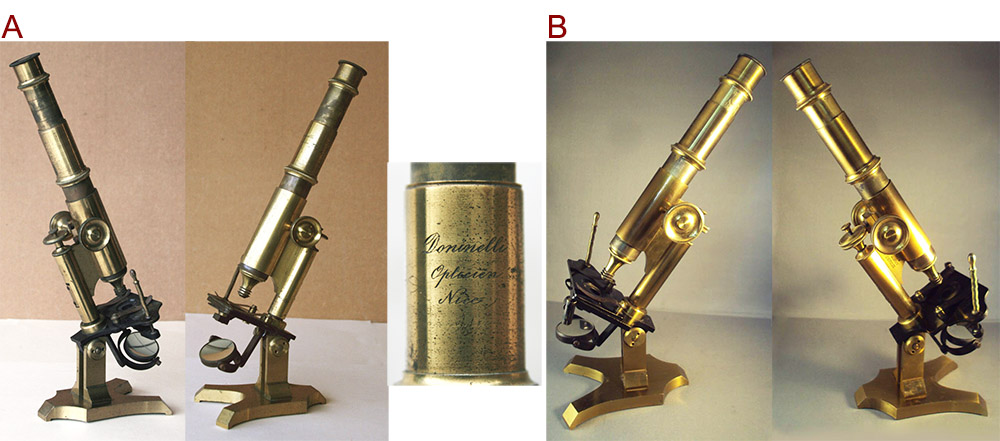
Figure 1.
A. “Continental”-footed microscope with a “Varley”/“Alfred White”-type mechanical stage, signed “Doninelli, opticien, Nice”.
B. An essentially identical microscope that is signed “Mirand Fils, Paris” (Jean Mirand, 1843 - ca. 1910). Mirand was described as manufacturing “microscopes approaching the English form” and “with a moveable stage and a lever”. I think that this Doninelli-signed microscope can be reasonably assumed to have been manufactured by Mirand. images adapted for nonprofit, educational purposes from an internet auction site or by permission from http://www.microscope-antiques.com/mirand.html.
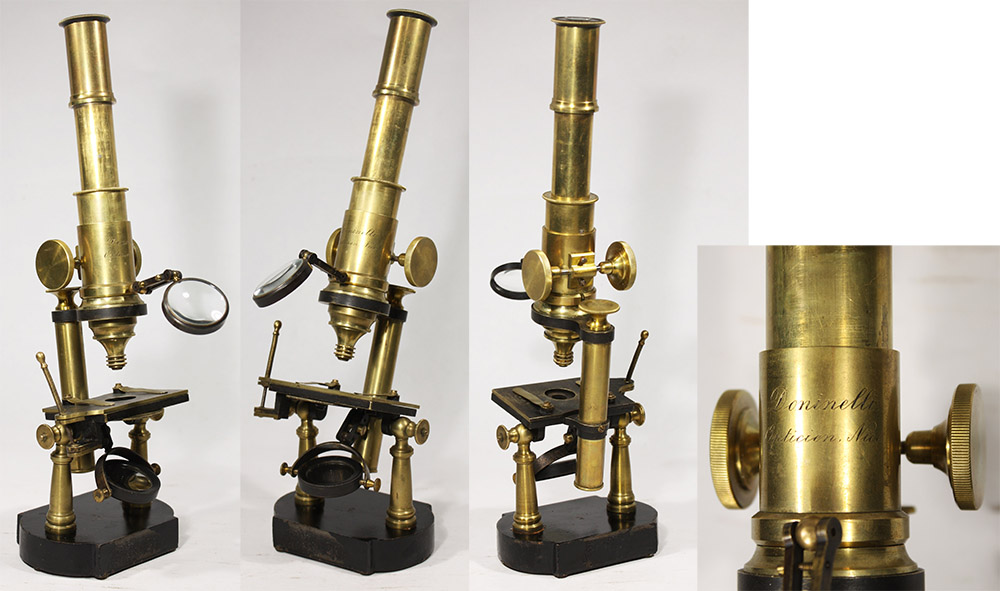
Figure 2.
A dual-column microscope that is engraved “Doninelli, opticien, Nice”. By comparison with other, similar microscopes, it is likely that this was manufactured during the late 1800s, and therefore retailed by Théodore Doninelli. The stage has an Alfred White-type “joystick” lever that adjusts the position of the stage in all directions on a horizontal plane, similar to that shown in Figure 1. The manufacturer of this microscope cannot yet be confidently ascribed.
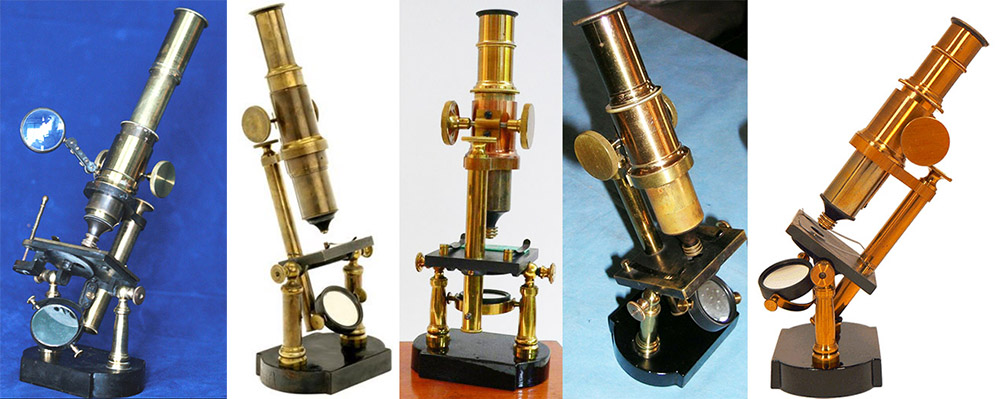
Figure 3.
Six additional examples of microscopes that have the same form of base as does the Doninelli-signed microscope that is shown in Figure 2. Top row, left to right, unsigned, signed “H. Müller”, signed “Pinot”, signed “Bourgeois, Paris”. Lower row, signed "Secrétan" and unsigned. The extensive similarities suggest that all may have been produced by the same manufacturer. Adapted for nonprofit, educational purposes from internet sale sites, or by permission from http://www.lecompendium.com/dossier_optique_22_microscope_a_double_colonne/microscope_a_double_colonne.htm.
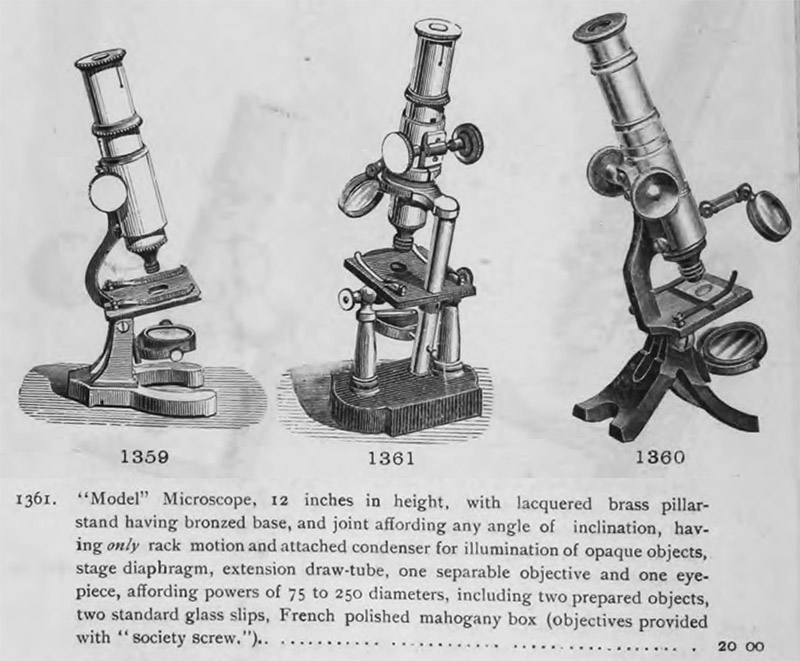
Figure 4.
Excerpt from a ca.1880 catalogue of B. Kahn & Son, New York, showing a microscope that is essentially identical to those in Figures 1 and 2, including the shape of the base.
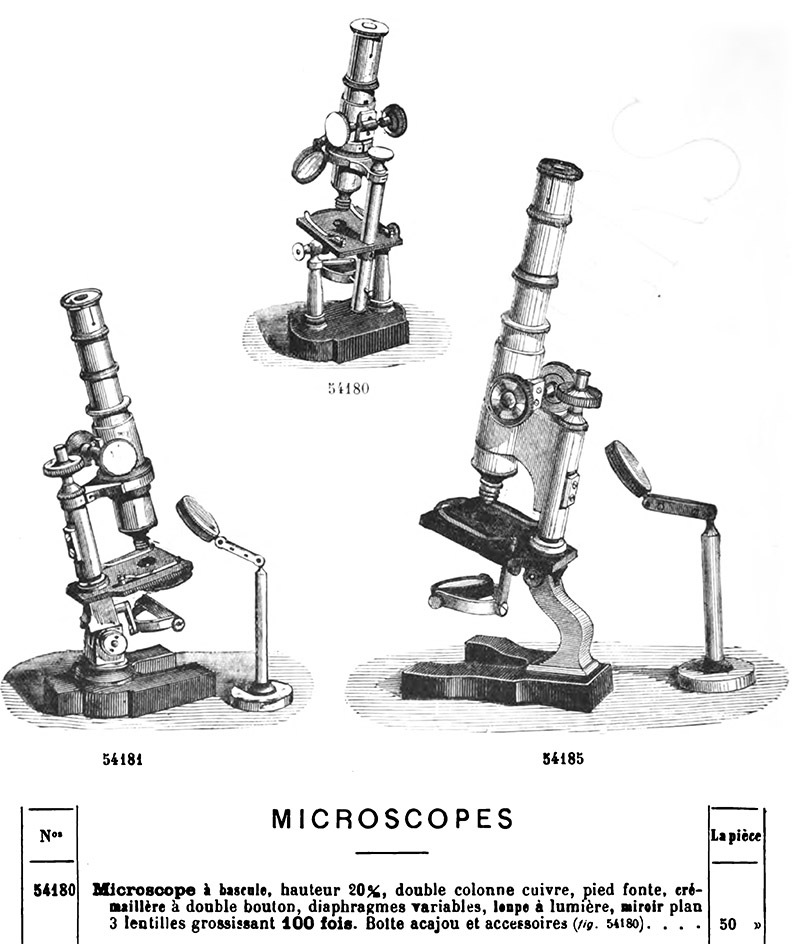
Figure 5.
Excerpt from the 1908 catalogue of Société des Lunetiers, Paris. This is the same engraving as in the Kahn catalogue (Figure 3), and shows extensive similarity to the microscopes shown in Figures 1 and 2. Société des Lunetiers was founded in Paris in 1849, and is still in business, under the name EssilorLuxottica.
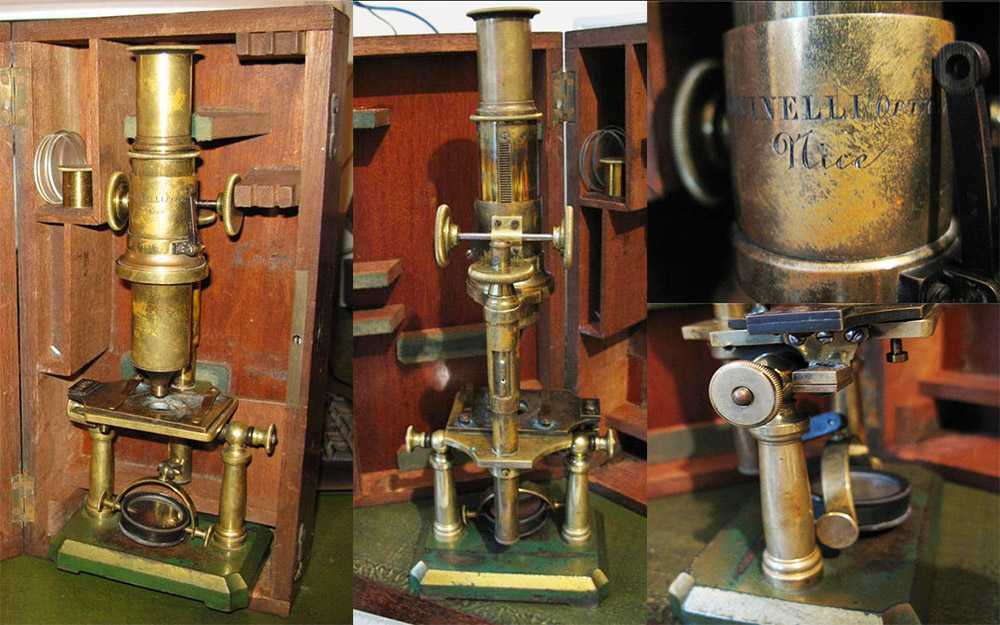
Figure 6.
A second form of dual column microscope that is signed by Doninelli. The base shape is distinct from those in Figures 2-5, and has a micrometer fine focus mechanism. It originally had a “Varley”/“Alfred White”-type mechanical stage, but the lever has been broken off. Adapted for nonprofit, educational purposes from an internet auction site.

Figure 7.
Additional examples of the second form of dual column microscopes. None are signed. Adapted for nonprofit, educational purposes from internet sale sites or by permission from http://www.antique-microscopes.com/photos/french_microscope.htm
and http://www.lecompendium.com/dossier_optique_117_microscope_a_double_colonne/microscope_a_double_colonne.htm.

Figure 8.
From a ca.1880 catalogue of B. Kahn & Son, New York, showing a dual column microscope with the same shape of the base and fine focus as the microscopes shown in Figure 5. The illustrated example has a rack-and-pinion coarse focus, whereas the instruments in Figure 5 have drawtube focusing – it was common for manufacturers to offer both forms of focus with the same model.
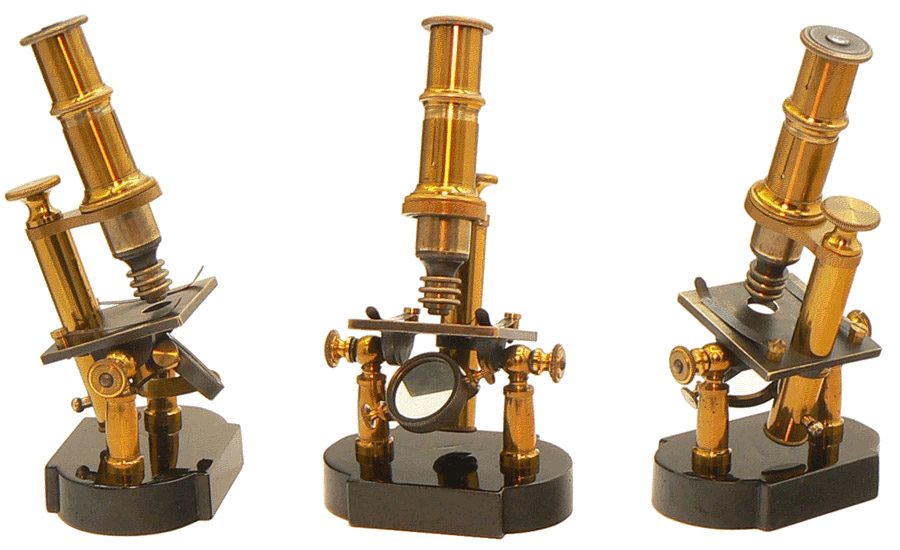
Figure 9.
A third form of dual column microscope, being much smaller than the other instruments shown on this page. The foot is very similar to that of the microscopes shown in Figure 2-5, and so may have been manufactured by the same maker. It is not signed. Adapted by permission from http://www.lecompendium.com/dossier_optique_227_microscope_miniature_a_double_colonne/microscope_miniature_a_double_colonne.htm.
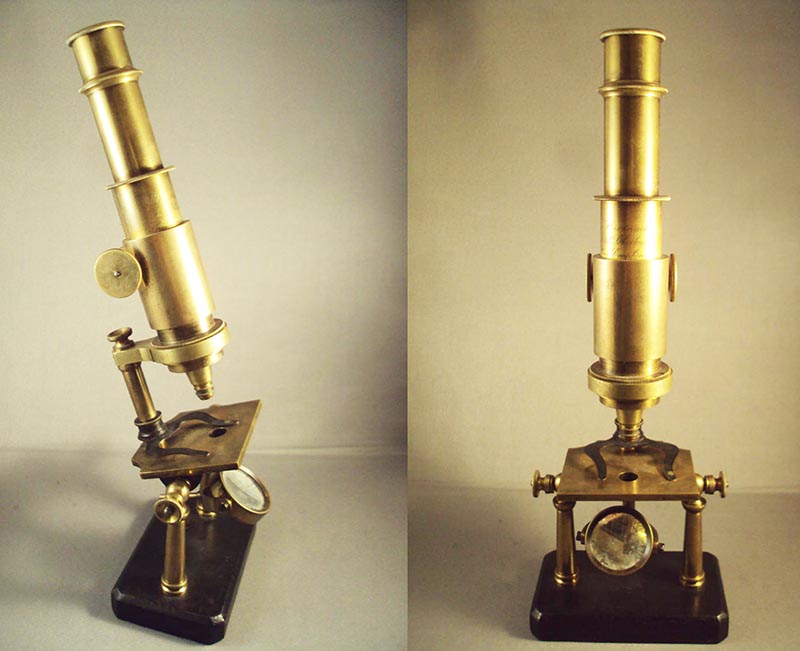
Figure 10.
A fourth type of dual column French microscope, with a base shape and other features that are distinct from the other microscopes shown in this page. It is engraved “E Hartnack Suc'r De G Oberhauser Place Dauphine 21 Paris”, dating it to between 1859, when Edmund Hartnack took over Georg Oberhauser’s optical business, and 1870, when Hartnack formed a partnership with Adam Prażmowski. It is likely that Hartnack’s firm manufactured this instrument, although the scarceness of such microscopes implies that this was probably not a major item in his inventory. Adapted with permission from http://www.microscope-antiques.com/doublepillar.html.
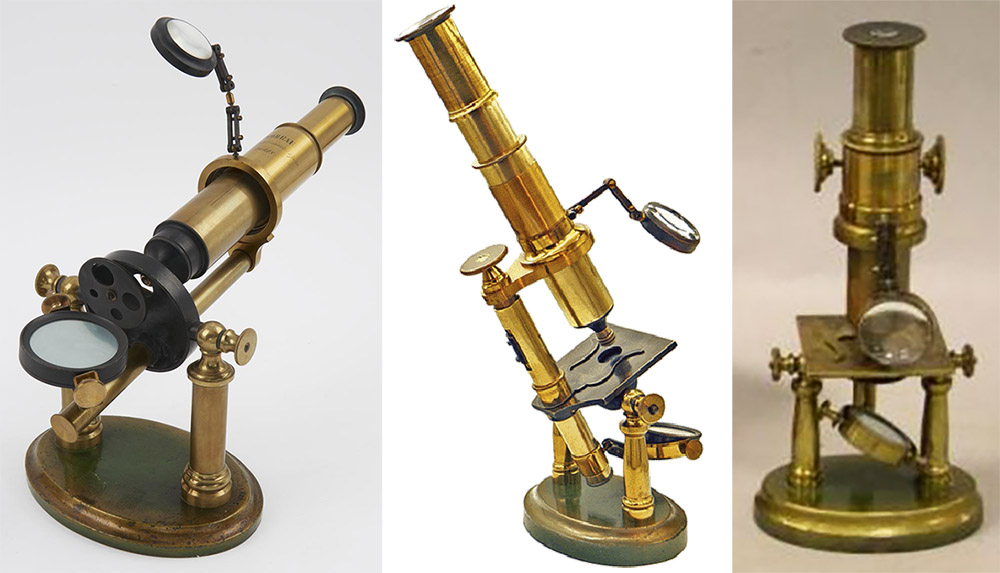
Figure 11.
�Another form of dual column microscope, with an oval base. The left microscope is signed “Moreau, Paris”, while those in the center and the right are unsigned. The shapes of the columns and stage of the Moreau microscope are rather different from the other two, suggesting that these instruments may have been made by two or more different manufacturers. Adapted for nonprofit, educational purposes from https://collection.sciencemuseum.org.uk/objects/co119395/compound-monocular-microscope-by-moreau-paris-mi-compound-monocular-microscopes,
http://www.lecompendium.com/dossier_optique_233_microscope_a_double_colonne/microscope_a_double_colonne.htm, and an internet auction site.
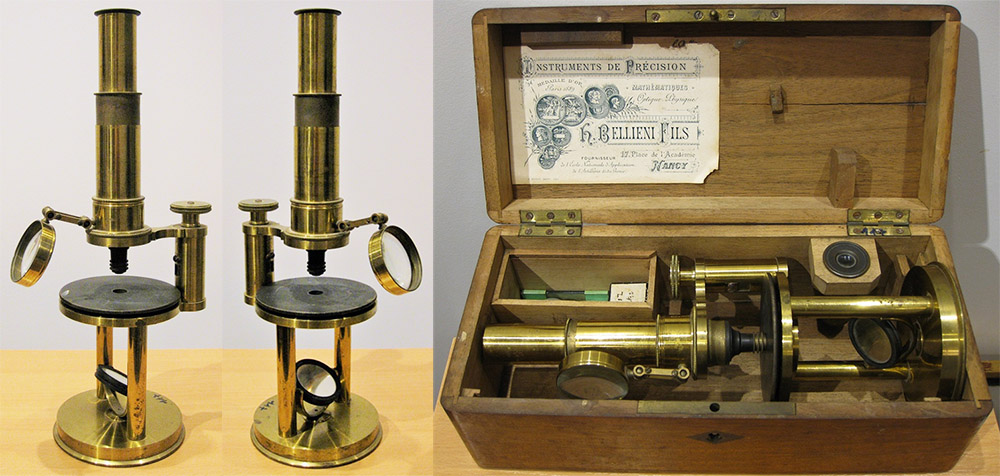
Figure 12.
Yet another form of dual column microscope, with a circular base. This particular microscope was retailed by H. Bellieni Fils, Nancy, France. The upper body does not tilt, but is held rigidly on the columns. It appears to be a transitional model, as French manufacturers evolved the drum style into the open, continental pattern. Adapted for nonprofit, educational purposes from an internet retail site.
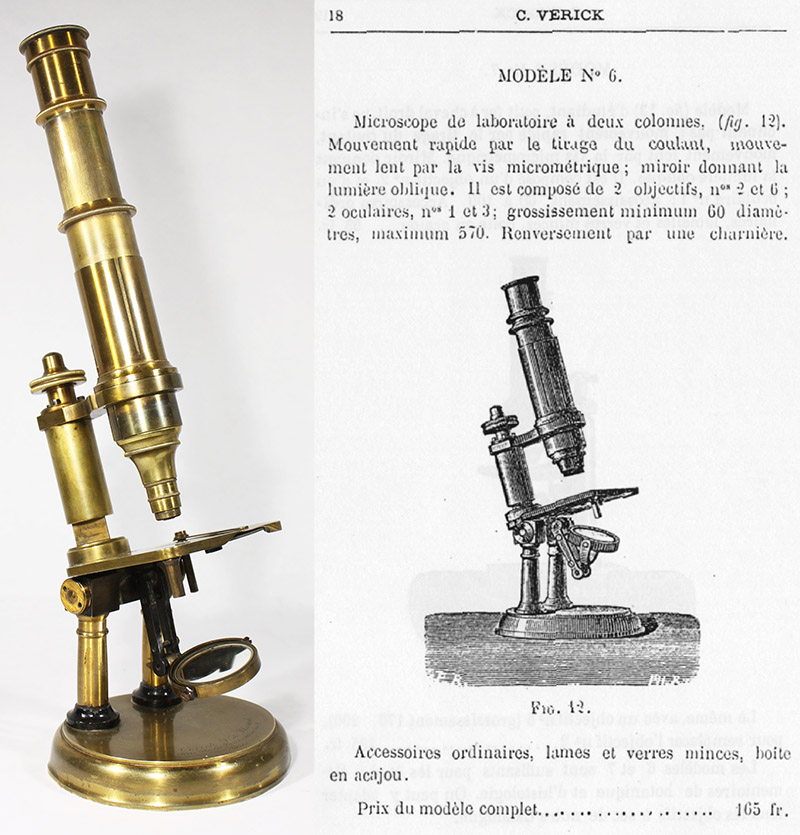
Figure 13.
This dual column microscope was a major product of Constant Verick, Paris, manufactured by him from the mid-1860s through at least 1890. It was listed in his catalogues as “Microscope de Laboratoire à Deux Colonnes”. Verick worked with Edmund Hartnack until 1866, this may have been an adaptation of the Hartnack model shown in Figure 7. Left, a ca. 1866 Verick microscope. Right, Excerpt from Verick’s 1885 catalogue.

Figure 14.
�An 1864 notice on Théodore Doninelli’s optical shop, from “Conseiller du Touriste à Nice et Dans ses Environs”.
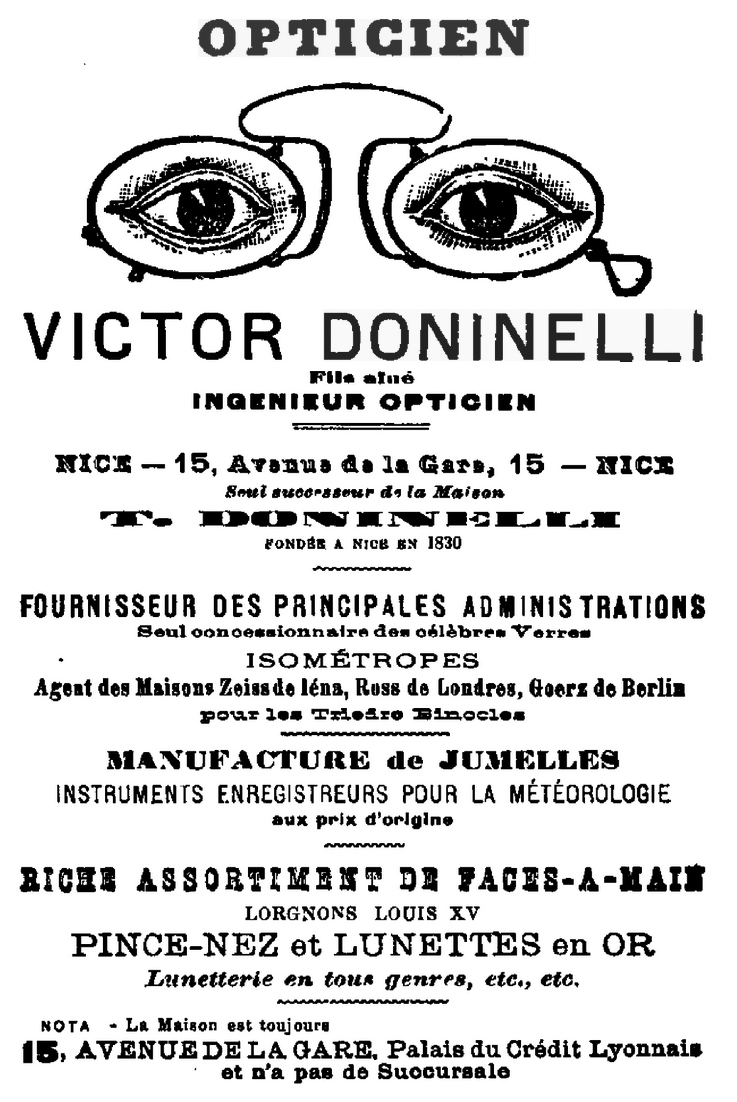
Figure 15.
A 1903 advertisement from Victor Doninelli, from “Guides des Pays d'Azur”. It states that Victor made binoculars (“jumelles”) and meteorological instruments.
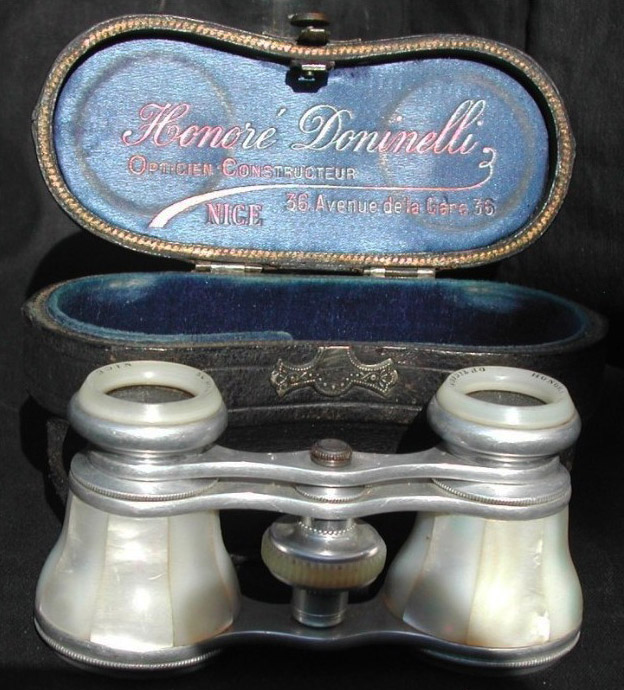
Figure 16.
Theater binoculars (“jumelles”), with a case signed Honoré Doninelli. He was probably Théodore’s grandson and Victor’s son. Adapted for nonprofit, educational purposes from an internet sale site.
Acknowledgements
Many thanks to Allan Wissner, Barry Sobel, Albert Balasse, and Joe Zeligs for graciously sharing pictures.
Resources
Annales de la Société des Lettres, Sciences et Arts des Alpes-Maritimes (1914) “En 1876, les observations quotidiennes de Teysseire ont recommencé à paraître mensuellement dans la revue Nice-Médical,où elles ont été continuées pendant plus de vingt ans, sauf quelques interruptions, qui vont être indiquées. En 1876, les observations étaient encore faites rue Croix-de-Marbre. Teysseire étant tombé malade cette même année, les observations ont été faites par T. Doninelli; d'abord au même endroit, puis au bout de quelques mois, au domicile de Doninelli, rue St-François-de-Paule, à une fenêtre au N.-E. jusqu'en octobre 1880, avec les instruments de Teysseire”, page 121
"C" (1867) Exposition Universelle, Hardwicke's Science-Gossip, Vol. 3, pages 121-122
Casimir, Philippe (1903) Guides des Pays d'Azurr, page 411
Conseiller du Touriste à Nice et Dans ses Environs (1864), page 86
microscope-antiques.com (accessed October, 2019) The lever stages of Alfred White and Cornelius Varley, https://www.microscope-antiques.com/leverstage.html
Nicole, Gustave (1860) Le Livre d'Or de la Savoie et de Nice, page 219
Pelletan, Jules (1876) Le Microscope: Son Emploi et ses Applications, Volume 1, Libraire de l'Academie de Medicine, Paris, pages 91 and 147
Pinon, Martin (1868) Annuaire Universel de tous les rites de la Maçonnerie Française et Etrangère, “Membres Actifs: Doninelli (Théodore), opticien, rue St-François de Paule, 7”, page 328















